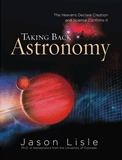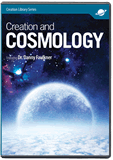
Star Formation and Creation
Can We See Stars Forming?
Keywords: stars, star formation, creation, infant stars, European Southern Observatory, Very Large Telescope Interferometer, VLTI, astronomy, creation scientists, disks, clouds, gas, dust
A recent article on the Internet was entitled “Infant Stars Caught in Act of Feeding.”1 New techniques are allowing astronomers to study disks of dust and gas around stars at very high levels of detail. The European Southern Observatory’s Very Large Telescope Interferometer (or VLTI) in Chile is able to measure at an angle so small, it would be like looking at the period of a sentence at a distance of 50 Kilometers (31 Miles). An interferometer combines the data from two or more telescopes that are separated from each other in such a way that the multiple telescopes act like one much larger telescope. A recent study looked at six stars known as Herbig Ae/Be objects, believed to be young stars still growing in size from their formation. This study was directed at finding what is happening to the dust and gas surrounding these stars.
Astronomers frequently report observations like this of “new stars” or “young stars,” which assume that these stars formed within the last few million years. Astronomers who believe the big bang and today’s other naturalistic origins theories would say stars can form in the present from clouds of dust and gas in space. Realize that no one saw these stars form. Instead, the properties of these stars, along with their location near gas and dust clouds where astronomers think that stars form is the basis for the belief that they are recently formed stars.
Young-universe creationist physicists and astronomers tend to be skeptical of reports claiming certain stars have recently formed. These claims often make many assumptions including that 1) the age of the star is known based on today’s accepted ideas of millions of years of stellar evolution and 2) that the dust disk surrounding the star had a role in the star’s formation. Evolutionary scientists would often assume the dust disk formed at about the same time as the star, though astronomers were not present to observe such events in the past.
Some creation scientists might argue that stars could not form after the Creation Week. However, others would say that stars could form after the Creation Week, but would argue that the naturalistic origins theories accepted today are not adequate explanations of the process. It is true that stars and other objects we have not seen before become visible to us all the time. There are a number of scientific reasons why scientists may see a star today that could not have been seen just days or weeks earlier in the same region of the sky. In the case of these Herbig Ae/Be stars, they simply were not observed before.
The recent observations of the six Herbig Ae/Be stars showed that for two cases gas was falling into the star, and, for the other four, gas was moving outward away from the star or from a disk around the star. Stars go through a variety of stages as they age. In some of these stages there are particularly strong stellar winds made up of charged particles that flow outward from the star, driving gas away from the star. However some stars are “quieter” so that gas is more likely to be pulled into the star by gravity. Either of these processes is possible in a creation view, so these observations are not surprising.
From a creation viewpoint, the interesting questions raised by these observations are about the age of the disks and which came first, the star or the disk. What was created in the Creation Week? Was it the star, the disk, or were both created by God at the same time? Was the star formed out of the disk at creation, though perhaps in a supernatural manner? Young-universe creationist scientists research these questions and have various opinions. It is important to note that just because gas is observed falling into the star, this does not necessarily mean that the disk had anything to do with the formation of the star.
There are always other possibilities that scientists with evolutionary assumptions do not consider. Disks (and clouds) of gas and dust could have been created when the stars were created, just several thousand years ago. The dust disks dissipate over time, and today, astronomers studying these disks find that the disks do not always fit their models. Recent research on dust disks has turned up examples of stars that according to accepted ideas of stellar evolution are old, yet they are observed to have extensive dust disks.2 Astronomers have generally believed that older stars could not still have dust disks. This calls into question the old-age assumptions regarding these disks and the stars found with them. George Rieke from the University of Arizona has recently commented on this problem, “We thought young stars, about 1 million years old, would have larger, brighter discs, and older stars from 10 to 100 million years old would have fainter ones . . . But we found some young stars missing discs and some old stars with massive discs.”3
The clouds in space that surround many stars are often as large as or larger than our entire solar system. This may suggest that the cloud has been there since Creation. However, some stars are found with smaller disks of dust and gas that could have originated in a collision of planets (extrasolar planets) orbiting the star.4,5 Extrasolar planets outside our own solar system are sometimes in elliptical orbits that could make planet collisions more likely than would be the case in our own solar system. There are over 200 cases of what are believed to be planets orbiting other stars.6 The existence of planets orbiting other stars does not conflict with a creation viewpoint, though Christians have reason to be skeptical about naturalistic planet origins theories.7
If some disks formed from collisions since creation, these disks would be very young in age and limited in size. On the other hand, if the disks were created in the Creation Week, they would still be only several thousand years old. An age of thousands of years means that the amount of change in the disk since the beginning would be limited. This seems to agree with this report about the six Herbig Ae/Be stars, which said that some of the stars had dust present closer to the star than was expected considering the temperature.8 It is not surprising to find evidence of gas near the star, but these observations suggest there are microscopic dust grains close to the star. Evolutionary scientists would expect that in millions of years, dust very near the star would be driven away or would be vaporized.
How young?
So, a question raised is why have the dust particles close to the star not evaporated when it is more than hot enough to vaporize them. This suggests the disks are very young indeed. To evolutionary scientists, the dust grains near the star would be perhaps hundreds of thousands to millions of years old. Over those kinds of time scales the dust could not still be so close to the star unless something keeps it from being too hot, e.g., gas shielding the dust from the star’s light. This is an example of how scientists assume processes they have not observed are at work in order to explain how the observed dust could still be present. Instead, why not consider the star and the disks to be only several thousand years old, then many of the difficulties of explaining the dust disks disappear.
Footnotes
- Andrea Thompson, “ Infant Stars Caught in Act of Feeding,” Fox News. See all footnotes
- Amazing Old Stars Give Birth Again, Space.com. See all footnotes
- Planets form like 'dust bunnies' , CNN.com. See all footnotes
- Two Planets Suffer Violent Collision, ScienceDaily.com. See all footnotes
- B. Zuckerman, Francis C. Fekel, Michael H. Williamson, Gregory W. Henry, M. P. Muno, Planetary systems around close binary stars: the case of the very dusty, Sun-like, spectroscopic binary BD+20 307, Astrophysical Journal (in press for December 10, 2008), also available at arxiv.org/abs/0808.1765. See all footnotes
- See exoplanets.org. See all footnotes
- Spencer, W., “The Existence and Origin of Extrasolar Planets,” TJ 15 no. 1 (2001):17–25. See all footnotes
- S. Kraus et. al., “The Origin of Hydrogen Line Emission for Five Herbig Ae/Be Stars Spatially Resolved by VLTI/AMBER Spectro-interferometry,” Astronomy and Astrophysics 489 (2008):1157–1173. See all footnotes
Recommended Resources

Answers in Genesis is an apologetics ministry, dedicated to helping Christians defend their faith and proclaim the good news of Jesus Christ.
- Customer Service 800.778.3390
- © 2025 Answers in Genesis






